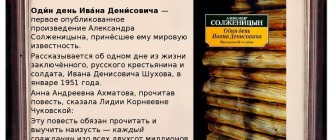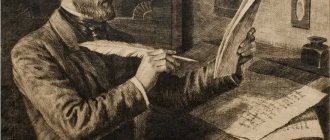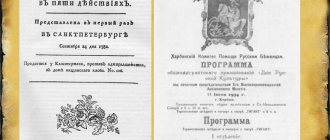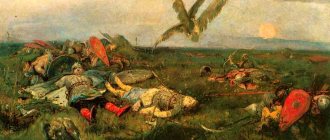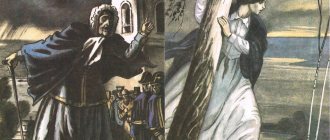The story “One Day in the Life of Ivan Denisovich” is a true depiction of the Siberian everyday life of victims of Stalin’s repressions. The work allows the reader to imagine what fate awaited those who did not please the Soviet regime. At school they study it in high school. The analysis of the work presented in the article will help you quickly prepare for the lesson and refresh your knowledge about the story before the Unified State Exam.
Brief Analysis
Year of writing – 1959.
History of creation - A. I. Solzhenitsyn conceived the work in the winter of 1950-1951, when he was in a camp in northern Kazakhstan. The plan was realized only 9 years later in 1959 in Ryazan.
Theme - The work develops the theme of camp life of political prisoners, victims of the Stalinist regime.
Composition - A.I. Solzhenitsyn described one day in the life of a prisoner, so the basis for the composition was the time frame from morning to evening, or rather, from getting up to lights out. The analyzed work is a weave of stories and thoughts in which details play an important role.
Genre - Short story, although before publication the editor recommended A. Solzhenitsyn to call his work a story, and the author heeded the advice.
Direction – Realism.
History of creation
The history of the creation of the work is connected with the camp life of A. Solzhenitsyn. The writer conceived it in 1950-1951. Then he served time in northern Kazakhstan. Later, Alexander Isaevich recalled: “In 1950, on some long winter camp day, I was carrying a stretcher with my partner and thought: how to describe our whole camp life?” He decided that a detailed description of one day in the life of those who were in “eternal exile” was sufficient. Alexander Isaevich began to implement the plan 9 years after returning from exile. It took about a month and a half to write the story (May-June 1959).
1961 is the year a version of the work was written without some of the more strident political aspects. In the same 1961, Solzhenitsyn handed over the manuscript to the editor-in-chief of the New World magazine A. Tvardovsky. The author did not sign the work, but A. Berzer, an editorial employee, added the pseudonym A. Ryazansky. The story made a “strong impression” on the editor, as evidenced by the entry in his workbook.
The editors suggested that Alexander Isaevich change the title: and the manuscript was called “Shch-854. One day for one prisoner." The publishers also made adjustments to the genre definition, proposing to call the work a story.
The author sent the story to fellow writers and asked for feedback on it. In this way he hoped to promote his work for publication. However, Alexander Isaevich understood that the work may not pass censorship. They turned to N. Khrushchev for help, and he obtained permission to publish. Solzhenitsen’s story “One Day in the Life of Ivan Denisovich” saw the world on the pages of the magazine “New World” in 1962.
The publication of the work was a grand event. Reviews about him appeared in all magazines and newspapers. Critics believed that the story became a destructive force for the hitherto dominant socialist realism.
On a different path
But in “One Day in the Life of Ivan Denisovich” Solzhenitsyn did not yet rise to historical generalizations, but talked about, as one of the critics wrote, “the camp through the eyes of a peasant.”
For people living at that time, the opportunity to openly talk about repression was extremely important, because it affected many in one way or another.
But the question is: who needs “Ivan Denisovich” in 2021? Especially this one, completely redone. Director Panfilov in an interview with Kommersant said: “I took a different path and came up with my own story of Ivan Denisovich based on the story. And it turned out: “Five days of Ivan Denisovich” - five key days of his life. Starting with the first - when, on the eve of the 1941 parade on Red Square, he arrived in Moscow to receive a new ZIS-3 gun and deliver it to his unit at his battery near Volokolamsk.”
“Stalin didn’t know what was going on”? 50 years and “One Day” Read more
Subject
To better assimilate the material from A. Solzhenitsyn’s story “One Day in the Life of Ivan Denisovich,” its analysis should begin with a description of the motives.
In the literature of the “post-Stalin” era, the motives of repression and exile actively develop. They occupy a special place in the works of writers who happened to visit the camps. The analyzed work reveals the theme of the life of political prisoners in exile. The main characters of the story are prisoners and guards.
A. Solzhenitsyn describes just one day in the life of a man exiled to the northern regions, Ivan Denisovich Shukhov, which determined the meaning of the title .
This is a peasant who honestly defended his Motherland at the front. Shukhov was taken prisoner, but he managed to escape, for which he was sent into exile. Inhuman living conditions could not kill the truly peasant soul. Ivan Denisovich retained his simplicity and kindness. At the same time, he was cunning. His inner core helped him survive.
In addition to Ivan Denisovich, there are other images of prisoners in the work. With undisguised admiration, A. Solzhenitsyn talks about Alyosha the Baptist, who, under the pressure of conditions, did not give up his views, about Ukrainians praying before meals. The reader can also watch the commander who took care of his charges like a real father.
Each image is a tool for revealing a certain facet of camp life. In the context of the main theme, the problems of the story are formed. Particular attention should be paid to the following problems: human cruelty, injustice of the regime, mutual assistance as a way of survival, love for one’s neighbor, faith in God. The author only raises pressing questions for his era, but the reader must draw his own conclusions.
The idea of the story is to show how a political regime can destroy destinies and cripple human bodies and souls. A. Solzhenitsyn condemns repression so that descendants do not make such mistakes.
The work “One Day in the Life of Ivan Denisovich”: analysis of the story
In the work “One Day in the Life of Ivan Denisovich” by A.I. Solzhenitsyn truthfully and honestly portrayed the daily life of victims of the Stalinist regime. The story describes everyday life in Siberia. After reading the work, the reader can draw his own conclusion about the conditions in which people lived who did not please the Soviet regime. A difficult fate awaited them.
The author decided to write a story while in a camp in Kazakhstan. This happened in the winter of the 50s. XX century. Nine years later, Alexander Solzhenitsyn brought his idea to life. In the work “One Day in the Life of Ivan Denisovich,” the author touched on the topic of camp life for political prisoners. A. Solzhenitsyn was deeply concerned about the existence of victims of Stalin's repressions.
In this work, the reader will encounter only one day in the life of a prisoner. The work consists of several stories that are intertwined. Particular attention is paid to thoughts, emotions, feelings. Alexander Solzhenitsyn focuses on details. He follows the movements of his hero, his reasoning.
Some critics believe that the work “One Day in the Life of Ivan Denisovich” belongs to the short story genre. However, before publishing the work, the editor advised the writer to rename his creation a story. A. Solzhenitsyn agreed with this opinion.
In the work, the author analyzes the motives of exile and repression. This topic was close to the writer; he knew about it firsthand. A. Solzhenitsyn's characters are in exile. They are political prisoners. The work also describes the supervisors. The main character, one day of whose life the reader lives with him, is a peasant. The character sincerely and honestly served his homeland. He fought at the front, defended his Fatherland. But Shukhov Ivan Denisovich was captured. The hero managed to escape. It was this event that became the reason for his exile. The character found himself in inhumane conditions. However, even injustice did not break his willpower, did not kill his sincere love for his native land.
The character had a kind heart, a real peasant soul. Despite the events that occurred, Ivan Denisovich was able to maintain his simplicity and faith in the best. But the character was not as simple as it seemed at first glance. He had a strong inner core and had his own opinion. The hero defended his position. It was these qualities that helped the prisoner survive in difficult conditions.
Alexander Solzhenitsyn also showed other prisoners in his work. The author admires some of the characters. These are the heroes who were able to defend their views and beliefs. On the pages of the book, the reader meets a commander who respects his charges and cares about them. There is no bitterness in the hero. He understands that other people could have taken the place of these prisoners.
Through the images of the characters, the author reveals the diversity of life in the camp. Among the main problems raised in the work “One Day in the Life of Ivan Denisovich”, one can highlight the problem of human cruelty, mutual assistance, and the injustice of the existing regime. The author is sure that the characters were helped to survive by love for their neighbors, empathy and support. Alexander Solzhenitsyn does not give his own assessment of the events taking place. The author only tells about the lives of the heroes. The reader must draw important conclusions for himself.
A. Solzhenitsyn in his creation managed to convey the feelings and emotions of those who faced the hardships of fate. The main idea of the work “One Day in the Life of Ivan Denisovich” is for the reader to understand what influence the political regime could have on people. For some, he destroyed the destinies, crippled not only their bodies, but also their souls.
Composition
The structure of the story is dictated by its content and the time frame of the events described. First, A. Solzhenitsyn talks about getting up at five o’clock in the morning. This is the exposition that takes the reader to the camp barracks and introduces him to the main character.
The development of events is all the troubles that Ivan Denisovich gets into during the day. First, he is found lying down after “getting up”, then he is sent to wash the floors in the guard’s room. Conversations with Alexei the Baptist and an agreement with the prisoner who received a rich parcel also relate to the development of events.
There are at least two climaxes in the work - the episode when the warden leads Shukhov to serve his sentence and the scene where Caesar hides food from the guards. Denouement - lights out: Shukhov falls asleep, realizing that he lived a happy day.
Stalin is a fool, smokes tobacco...
Do you want to have a serious conversation about that time? If you don’t wait, Panfilov will twist the barrel at you in the best traditions of Ogonyok in the late 1980s. Again we have before us a real hero, who has become an innocent victim of Soviet tyranny, which is ready to wipe everyone and everything into the camp dust.
It would seem that it had long been established that there was no general accusation of prisoners of war of treason, and those who ended up in the Soviet camp constituted an absolute minority. And the Gulag system itself looked different in different years and in different places, and it had nothing in common with Hitler’s system of extermination.
What to do, for example, with the fact that the author of “One Day in the Life of Ivan Denisovich”, in this very system of total destruction that the Gulag depicts, was cured of cancer? How does this fit into the pictures drawn by him and drawn by those who make films based on his works?
The case of Professor Kurganov. Who came up with 110 million victims of Stalin? More details
Genre
A.I. Solzhenitsyn, at the insistence of the editors, defined the work as a story. In fact, this is a story. In it one can notice the following signs of a small literary genre: small volume, the author’s attention is concentrated on Shukhov’s storyline, the system of images is not very branched. The direction of the work is realism, as the author truthfully describes human life.
Previous
Essays "Doctor Zhivago" analysis of Pasternak's work - problems, history of creation, genre originality, meaning of the title of the novel
Next
Essays “Lady with a Dog” analysis of Chekhov’s work – issues, theme, problems, main idea of the story
